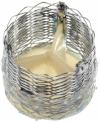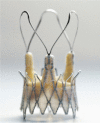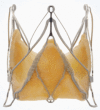Next-generation transcatheter heart valves: current trials in Europe and the USA
- PMID: 22891121
- PMCID: PMC3405796
- DOI: 10.14797/mdcj-8-2-9
Next-generation transcatheter heart valves: current trials in Europe and the USA
Abstract
Transcatheter aortic valve implantation (TAVI) has proven to be a viable alternative for patients with symptomatic severe aortic stenosis who are at high risk for surgical aortic valve replacement. At the same time, there is increasing evidence that moderate-to-severe periprosthetic aortic regurgitation after TAVI is associated with dramatically increased mortality and morbidity. The issue of proper positioning of the valve, including the ability to reposition and recapture the device, must be dealt with before the use of TAVI can be extended to younger, healthier patients. The next generation of transcatheter heart valves will most likely address repositionability to facilitate accurate placement with additional features that minimize paravalvular leakage. Upcoming devices promise to improve outcomes and usability of current TAVI systems.
Keywords: Aortic stenosis; TAVI; paravalvular leakage; periprosthetic regurgitation; transcatheter aortic valve implantation.
Figures
Similar articles
-
Clinical studies assessing transcatheter aortic valve replacement.Methodist Debakey Cardiovasc J. 2012 Apr-Jun;8(2):13-8. doi: 10.14797/mdcj-8-2-13. Methodist Debakey Cardiovasc J. 2012. PMID: 22891122 Free PMC article. Review. No abstract available.
-
Role of transcatheter aortic valve implantation (TAVI) versus conventional aortic valve replacement in the treatment of aortic valve disease.Methodist Debakey Cardiovasc J. 2012 Apr-Jun;8(2):4-8. doi: 10.14797/mdcj-8-2-4. Methodist Debakey Cardiovasc J. 2012. PMID: 22891120 Free PMC article. Review.
-
Transcatheter aortic valve replacement (TAVR): access planning and strategies.Methodist Debakey Cardiovasc J. 2012 Apr-Jun;8(2):22-5. doi: 10.14797/mdcj-8-2-22. Methodist Debakey Cardiovasc J. 2012. PMID: 22891124 Free PMC article. Review.
-
Room considerations with TAVR.Methodist Debakey Cardiovasc J. 2012 Apr-Jun;8(2):19-21. doi: 10.14797/mdcj-8-2-19. Methodist Debakey Cardiovasc J. 2012. PMID: 22891123 Free PMC article.
-
Multimodality noninvasive imaging for transcatheter aortic valve implantation: a primer.Methodist Debakey Cardiovasc J. 2012 Apr-Jun;8(2):29-37. doi: 10.14797/mdcj-8-2-29. Methodist Debakey Cardiovasc J. 2012. PMID: 22891126 Free PMC article. Review.
Cited by
-
Transcatheter valvular therapies in patients with left ventricular assist devices.Front Cardiovasc Med. 2023 Mar 13;10:1071805. doi: 10.3389/fcvm.2023.1071805. eCollection 2023. Front Cardiovasc Med. 2023. PMID: 36993995 Free PMC article. Review.
-
Transcatheter aortic valve replacement: current application and future directions.Curr Cardiol Rep. 2013 Apr;15(4):353. doi: 10.1007/s11886-013-0353-7. Curr Cardiol Rep. 2013. PMID: 23420448 Review.
-
Clinical significance of conduction disturbances after aortic valve intervention: current evidence.Clin Res Cardiol. 2015 Jan;104(1):1-12. doi: 10.1007/s00392-014-0739-6. Epub 2014 Jul 4. Clin Res Cardiol. 2015. PMID: 24990451 Review.
-
Vascular complications post-transcatheter aortic valve procedures.Indian Heart J. 2016 Sep-Oct;68(5):724-731. doi: 10.1016/j.ihj.2015.11.024. Epub 2016 Jan 12. Indian Heart J. 2016. PMID: 27773416 Free PMC article. Review.
-
Predictive value of the Fibrosis-4 index in patients with severe aortic stenosis undergoing transcatheter aortic valve replacement.Clin Res Cardiol. 2022 Dec;111(12):1367-1376. doi: 10.1007/s00392-022-02055-6. Epub 2022 Jul 19. Clin Res Cardiol. 2022. PMID: 35852581
References
-
- Cribier A, Eltchaninoff H, Bash A, Borenstein N, Tron C, Bauer F, et al. Percutaneous transcatheter implantation of an aortic valve prosthesis for calcific aortic stenosis: first human case description. Circulation. 2002 Dec 10;106(24):3006–8. - PubMed
-
- Grube E, Laborde JC, Gerckens U, Felderhoff T, Sauren B, Buellesfeld L, et al. Percutaneous implantation of the CoreValve self-expanding valve prosthesis in high-risk patients with aortic valve disease: the Siegburg first-in-man study. Circulation. 2006 Oct 10;114(15):1616–24. - PubMed
-
- Leon MB, Smith CR, Mack M, Miller DC, Moses JW, Svensson LG, et al. Transcatheter aortic-valve implantation for aortic stenosis in patients who cannot undergo surgery. N Engl J Med. 2010 Oct 21;363(17):1597–607. - PubMed
-
- Smith CR, Leon MB, Mack MJ, Miller DC, Moses JW, Svensson LG, et al. Transcatheter versus surgical aortic-valve replacement in high-risk patients. N Engl J Med. 2011 Jun 9;364(23):2187–98. - PubMed
-
- Sinning JM, Walenta K, Werner N, Böhm M. Hotline update of clinical trials and registries presented at the 77th spring meeting of the German Society of Cardiology 2011. Clin Res Cardiol. 2011 Jul;100(7):553–60. - PubMed
Publication types
MeSH terms
LinkOut - more resources
Full Text Sources
Medical







